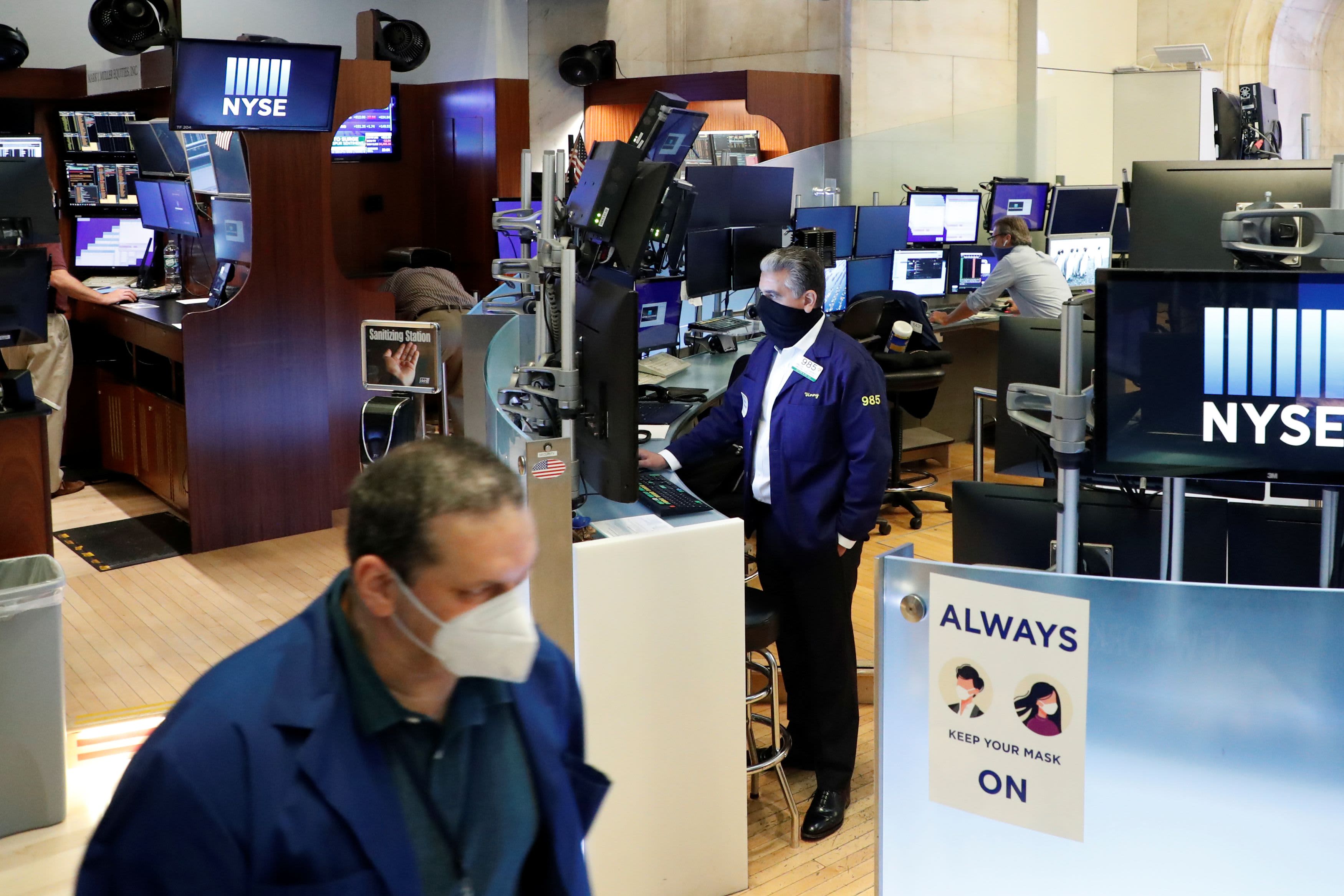Traders with masks work on the first day of in-person trading since the closure during the outbreak of the coronavirus disease (COVID-19) on the floor at the New York Stock Exchange (NYSE) in New York, U.S., May 26, 2020.
Brendan McDermid | Reuters
This summer’s heavy speculation in stock options helped drive frothy prices, and now it could create move volatility than normal in some of the market’s best-loved stocks, as investors go through the quarterly process of expirations.
Options on stocks, ETFs, indexes and futures expire on the third Friday of the last month of the quarter, which is this Friday. Investors either close out those positions or roll them forward. As a result, quarterly expirations create huge volume in the stock market as brokers on the other side of the options buy or sell securities into the expiration.
“It definitely has the possibility of being very volatile,” said Julian Emanuel, head of equity and derivatives strategy at BTIG. “The tendency is that all of the fireworks are on Wednesdays or Thursdays…There’s going to be enormous stock volume tomorrow like there always is.”
The expiration comes as much attention has focused on large amounts of betting in options in the biggest tech and momentum names, and much of the positioning has been bullish in call options that bet the underlying stocks will go higher. Some of the action is the result of big investors, like SoftBank, but another big driver has been retail investors.
“If we assume that retail is long a lot of these September expiring calls in stocks like Apple and Tesla and the market continues to move lower, due to the aftermath of the Fed, market makers unwind their hedges against those long calls. In theory, that could exacerbate the move lower, but it really works in either direction,” said Chris Murphy, Susquehanna Financial co-head of derivative strategy.
Murphy said retail investors are much more involved in options on individual stocks than they were a year ago.
“If you want to see the difference, equity open interest from this September to last September is up significantly, to 55 million from 40 million. That compares to open interest in ETFs. That was 29.25 million and now it’s down to 28.9 million,” he said. Murphy said individual investors may be more inclined to trade single stocks while institutions and bigger investors could be move involved in ETFs and indexes. Open interest, or the total open contracts, on the indexes like the S&P 500 also fell to 4.5 million from 5.1 million.
With the shift in focus to individual stock names, that could make trading in those issues more volatile in both directions for the rest of the week. According to Goldman Sachs, options volumes in 50 single stocks accounts for 89% of the notional volumes for all individual equity options.
Emanuel said he’s not concerned excessive moves in stocks around expiration, but in general he has been concerned about aggressive buying in out-of-the-money calls in a few stocks. Those calls, which bet on big moves higher, are priced at historic premiums to out-of-the-money puts, which bet on falling stock prices. Normally, it is more expensive to hedge against a downside move, but now it is more expensive in some names to hedge a move higher.
“I’m worried about it within the context that it’s just another one of the signs that these stocks are over-owned ad over-loved, and rightly so, given their performance and the momentum throughout August,” he said. But that type of options buying is acting as a negative warning for stocks, and it still illustrates too much froth.
Emanuel said there was a turn in sentiment when the market sell-off Sept. 2, but the options positioning in some high-flying names has not changed. “They are still pricing in FOMO [fear of missing out], instead of fear,” he said.
As for this week’s expirations, Murphy said the Fed is the bigger driver of the stock market, but options positioning can be exaggerating moves in either direction.
“Now that we’ve moved through some of the lower strikes, the market makers who are hedged with long stock, now sell the stock,” said Murphy. He pointed to Apple as an interesting example. The stock was off its lows in late morning trading, and just below the level where there is a lot of options interest.
“The highest open interest strike is September $112.50,” he said. “Yesterday’s close was above it. Today we’re below it, so it’s in play … If we make the assumption retail is long and the market maker is short, as the stock trades above $112.50, there will have to be buying to hedge and that could exacerbate a move higher. If it goes back below, there needs to be selling. They don’t need as much of a hedge.”
Goldman Sachs analysts said in a note that investors have been concerned about the high concentration of activity in a few names, while options activity is at record levels. So Goldman studied it and found that options activity is typically concentrated in a relatively small number of stocks.
For instance, since 2006, at various times, the top five stocks, in terms of options activity, had accounted for 25% to 75% of single stock notional volumes.
Goldman studied a period in 2012 to 2013, when five stocks were at all time highs and also saw the most options activity. They were Apple, Amazon, Alphabet, Netflix and Booking Holdings, then Priceline. It did not have an adverse impact on the stock market. The S&P 500 returned 45% over the two years, and the VIX, the Cboe Volatility Index, declined to 14 at the end of 2013, from 24 at the end of 2011.
